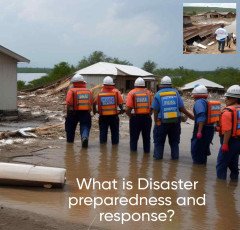
What is Climate Change and health ?

Long-term changes in the earth's temperature, precipitation, and other environmental variables brought on by human activities such the combustion of fossil fuels, deforestation, and industrial operations are referred to as climate change.
As they have the potential to either create or exacerbate a number of health issues, these alterations have a substantial impact on human health.
Health can be impacted by climate change in a variety of ways, including:
Increased concentrations of air pollutants like ozone and particle matter, which include these can lead to respiratory issues, cardiovascular illness, and early mortality.
Extreme weather occurrences, such as hurricanes, floods, droughts, and increasingly frequent and severe heat waves, can cause accidents, illnesses, and even fatalities.
Malaria, dengue fever, and the Zika virus are examples of vector-borne illnesses that can spread as a result of temperature and precipitation changes.
Changes in temperature and precipitation patterns can also have an impact on the quality of food and water, which can result in outbreaks of diseases including salmonella, E. coli, and cholera.
Mental health:
People who experience extreme weather events or are displaced due to climate-related disasters may experience stress, anxiety, depression, and post-traumatic stress disorder (PTSD) as a result of climate change.
Deforestation, biodiversity loss, and soil degradation are examples of environmental degradation that can be exacerbated by climate change and have indirect effects on human health.
Human health and well-being are seriously threatened by climate change, and individuals, communities, governments, and international organizations must work together to confront this challenge.
The effects of climate change on human health are already being seen, and it is anticipated that they will get worse in the years to come.
According to the World Health Organization (WHO), approximately 150,000 deaths are attributed to climate change each year, and this number is expected to rise.
The effects of climate change on health are not uniformly spread, and vulnerable groups like kids, the elderly, those living in low-income areas, and people who already have health issues are particularly at danger. Additionally, as individuals who have less access to resources like clean water and healthcare are more likely to experience climate-related health issues, climate change has the potential to worsen already existing health disparities and inequities.
To protect human health, it is essential to reduce greenhouse gas emissions and take action to adapt to the effects of climate change.
This can involve actions like increasing illness detection and response systems, supporting food and water security, and making investments in infrastructure and healthcare systems that are climate resilient. Individuals can also support policies that address climate change, reduce their carbon footprint, and promote climate action at the local, national, and international levels.
For the purpose of fostering sustainable and healthy communities and guaranteeing that every person has the chance to grow and realize their full potential, it is imperative to address the effects of climate change on health.
There are enormous expenses associated with the effects of climate change on the economy and society in addition to the health effects.
Health issues brought on by the climate can result in higher medical expenses, lost productivity, and decreased quality of life for people and communities. Extreme weather conditions and other climate-related catastrophes can also cause substantial financial losses, property damage, and population displacement.
Addressing the effects of climate change on health is not only morally required but also economically necessary.
We can preserve human health by reducing greenhouse gas emissions and fostering climate resilience, but we can also open up new economic opportunities and advance social and environmental justice.
A just transition to a low-carbon economy, in which the advantages and disadvantages of addressing global warming are properly spread across society, is also being increasingly understood. To do this, it is necessary to interact with communities and stakeholders to make sure that their views are heard, that their concerns are taken seriously, and that they are involved in the processes that determine climate policy and action.
People, communities, governments, and international organizations must work together to solve the challenge of climate change, which poses a serious threat to human health and wellbeing. We can safeguard human health, open up new economic opportunities, and create a more just and sustainable world by adopting steps to cut greenhouse gas emissions and encourage climate resilience.
To address the effects of climate change on health, a variety of techniques can be used. Some of these tactics consist of:
The most efficient strategy to address the underlying causes of climate change and its negative effects on health is to reduce greenhouse gas emissions. This may entail taking steps to switch to renewable energy sources, increase energy efficiency, and support environmentally friendly modes of transportation.
Improving air quality can have an immediate and considerable positive impact on people's health, especially those who already have respiratory and cardiovascular diseases. This can involve taking steps to lower emissions from industry and transportation, support the use of cleaner energy sources, and enhance indoor air quality.
Increasing disease surveillance and response:
Improving surveillance systems for vector-borne diseases and other climate-sensitive illnesses can aid in the quicker and more efficient detection of epidemics.
In order to maintain human health, especially in places hit by drought or flooding, it is crucial to ensure access to safe and dependable supplies of water and food.
Putting money into infrastructure and healthcare systems that are climate resilient: The hazards to people's health and wellbeing can be decreased by making sure that infrastructure and healthcare systems are built to withstand the effects of climate change.
Promoting behavior change:
There are numerous advantages for the environment and human health associated with encouraging people and communities to adopt more sustainable behaviors, such as cutting back on energy use, using public transportation, and minimizing trash.
A thorough and multifaceted strategy is needed to address the effects of climate change on health. We can build a more sustainable and healthy future for all people by cooperating on a local, national, and international scale.
Individuals can also adopt a variety of steps to lessen their own carbon footprints and encourage climate resilience. Some examples of these actions are:
Reduce energy use:
This may be done by taking simple steps like turning off the lights when you leave a room, utilizing energy-efficient equipment, and running the air conditioner less often.
Utilize environmentally friendly modes of transportation:
Walking, bicycling, or taking the bus or train instead of driving can help cut emissions and improve air quality.
Reduce your meat intake:
Because the production of meat and dairy products contributes significantly to greenhouse gas emissions, switching to a plant-based diet or cutting back on your meat intake can benefit the environment and your health.
Reduce waste:
This can be done by recycling, composting, and consuming less single-use plastic.
Support climate policy and action:
Supporting local and national climate policies, voting for political candidates that emphasize climate action, and engaging in climate advocacy and activism can all assist to advance climate change action.
Individuals can lower their own carbon footprint and encourage climate resilience in their communities by engaging in these activities. But it's crucial to keep in mind that everyone—from individuals to governments and international organizations—must work together to address the effects of climate change on health.
Yes, tackling the effects of climate change on health requires collaborative action. Governments and international organizations must play a significant role in promoting laws and initiatives that deal with the causes of climate change and its negative effects on human health.
Some important policy tactics that can be used are as follows:
Carbon pricing is assigning a cost to carbon emissions in an effort to promote the shift to a low-carbon economy and lower greenhouse gas emissions.
Renewable energy production goals:
Setting goals for renewable energy production might encourage the creation and use of clean energy technology.
Energy efficiency requirements:
Setting minimum requirements for the energy efficiency of buildings, cars, and appliances can assist to cut down on energy use and greenhouse gas emissions.
Promoting public transportation, bike lanes, and other environmentally friendly modes of transportation can help cut down on transportation-related emissions.
Land use and conservation policies:
Promoting sustainable agricultural methods, encouraging the switch to regenerative agriculture, and protecting forests and other natural areas can all contribute to lower emissions and boost resilience.
Strategies for coping with the effects of climate change, such as extreme weather conditions and increasing sea levels, should be developed and put into practice in order to lessen the risks to human health and wellbeing.
Governments and international organizations can support the promotion of sustainable and healthy communities for all by adopting a comprehensive and integrated approach to climate policy and action.
The business sector has a significant role to play in addressing the effects of climate change on health, in addition to government intervention. Businesses may promote sustainable practices, lessen their own carbon footprint, and create innovative technologies and products that support sustainability and climate resilience.
Some crucial tactics that companies might use are as follows:
Measurement and reporting of greenhouse gas emissions, defining reduction goals, and putting those goals into action are all steps that can help businesses lessen their carbon footprints and advance sustainability.
Investing in renewable energy and energy efficiency:
Companies can both increase their operational energy efficiency and invest in renewable energy technologies like solar and wind power.
Sustainable supply chain management can help to lower emissions and advance sustainability by promoting sustainable practices along the entire supply chain, such as responsible sourcing and waste reduction.
Product innovation can aid in hastening the shift to a low-carbon economy by creating new goods and technology that support sustainability and climate resilience, such as electric cars and renewable energy sources.
In order to maintain the resilience of their operations and supply chains, businesses can establish plans to manage the risks related to climate change, such as those posed by extreme weather occurrences.
Businesses can take these steps to promote sustainability, lessen their own carbon footprint, and contribute to more comprehensive efforts to address the effects of climate change on health and well-being.
International efforts to combat climate change and advance health can also be supported by individuals, governmental entities, and commercial enterprises. The Paris Agreement, which was adopted in 2015, establishes a framework for limiting global warming to well below 2 degrees Celsius above pre-industrial levels and pursuing efforts to limit warming to 1.5 degrees Celsius. The United Nations Framework Convention on Climate Change (UNFCCC) provides a platform for international cooperation and action on climate change.
There are several international organizations trying to enhance climate resilience and health in addition to these global agreements. The Climate and Health Alliance and the Global Climate and Health Alliance are two programs and efforts that the World Health Organization (WHO), a major participant in this field, has developed to address the health implications of climate change.
Individuals, governmental entities, and commercial enterprises can contribute to the development of a more resilient and sustainable future for all by supporting international initiatives to combat climate change and advance health.
Yes, it is essential to support international efforts to combat climate change and advance health.
However, it's crucial to understand that different regions and communities might be affected by climate change in various ways, and that in order to be effective, solutions must be adapted to the unique requirements and conditions of these groups.
For instance, minority groups and low-income communities may be more severely affected by climate change and have fewer means to adapt to its effects. Therefore, it's critical to make sure that programs and policies related to climate change are created with equity and social justice in mind.
It's also critical to acknowledge the contribution traditional and Indigenous knowledge can make to fostering climate resilience and wellness. Native American tribes have a history of interacting with their regional ecosystems, and their traditional knowledge and ways of life can offer important insights into how to adapt to the effects of climate change.
A multifaceted and integrated approach involving individuals, governments, companies, and international organizations is necessary to address the effects of climate change on health. We can build a more resilient and healthy future for everyone if we all work together to advance sustainability, equity, and social justice.
Various stakeholders must work together and take a multifaceted strategy to address the effects of climate change on health.
Following are some concrete actions that can be performed to advance health equity and climate resilience:
Engaging communities:
Incorporating community viewpoints and needs into climate policies and initiatives will help guarantee that solutions are suited to each group's unique requirements and improve health equity.
Investing in climate-resilient infrastructure can assist to lower the risks to human health and well-being. Such infrastructure can resist the effects of climate change, such as extreme weather events.
Supporting clean energy technology can assist to reduce greenhouse gas emissions and create sustainable and healthy societies. Examples of clean energy technologies include solar and wind power.
Promoting sustainable agricultural methods can assist to lower greenhouse gas emissions, advance biodiversity, and support the health of ecosystems and communities. One such method is regenerative agriculture.
Creating methods for the management of climate-related hazards, such as those posed by extreme weather conditions and rising sea levels, can assist to lessen the dangers to people's health and well-being.
By doing these actions, we may encourage health equity and climate resilience and build a more sustainable and sustainable future for all.
Along with taking these actions, it's critical to spread knowledge and understanding of the connections between climate change and health. This entails educating the general public on the effects of climate change on health as well as the steps that people may take to lessen their own carbon footprint and advance sustainability.
Individuals can improve climate resilience and health equity in a variety of ways, including the following:
Reducing energy use can assist to lower greenhouse gas emissions and promote sustainability. This can be done by turning off lights, adopting energy-efficient appliances, and using less heating and cooling in homes and businesses.
Promoting environmentally friendly transportation:
Taking the bus, walking, or bicycling instead of driving alone can help cut greenhouse gas emissions and support environmentally friendly and wholesome communities.
Supporting local, sustainable food systems can help cut greenhouse gas emissions, encourage biodiversity, and enhance the wellbeing of communities and ecosystems. Examples of such systems include farmers' markets and community gardens.
Advocating for climate policies can contribute to the development of a more resilient and healthier future for all. Climate policies and initiatives that support sustainability and health equity are particularly important.
People may support climate resilience and health equity in their own communities and abroad by engaging in these activities.
In the end, combating the effects of climate change on health necessitates a thorough and cooperative strategy that encompasses people, governments, companies, and international organizations cooperating for a sustainable and healthy future.
Yes, dealing with the effects of climate change on health necessitates a thorough and collaborative strategy including several stakeholders. Along with the previously mentioned procedures, there are other crucial techniques that can be used to advance climate resilience and health equity, such as:
Prioritizing climate justice can assist to lessen the disproportionate effects of climate change on marginalized populations and advance health equity. This can be done by ensuring that climate policies and initiatives are planned with equity and social justice in mind.
Enhancing public health systems can help to better manage the negative effects of climate change on human health, such as outbreaks of diseases that are sensitive to the climate.
Investing in research: Research may serve to inform and guide decision-making and promote evidence-based action.
Research can help to better understand the connections between climate change and health, as well as effective interventions and policies.
Creating green spaces:
Creating green areas, such parks and urban gardens, can help to reduce the urban heat island effect and offer chances for exercise and social interaction.
Building climate resilience in health systems can help to ensure that they are better able to deal with the effects of climate change and continue to provide crucial health services during extreme weather events or other emergencies. Building climate resilience in health systems includes hospitals and health clinics.
We can enhance climate resilience and health equity and build a more sustainable and healthy future for everyone by adopting a comprehensive strategy that incorporates these and other tactics.


















 Online Technology Classes
Online Technology Classes  NordVPN
NordVPN  Graphics & Design
Graphics & Design  Echo Dot - Smart speaker with Alexa
Echo Dot - Smart speaker with Alexa  Kitchen Tap
Kitchen Tap  Dell Laptop
Dell Laptop  Pet Care Products
Pet Care Products  Unreal Engine 5 For Beginners Learn The Basics Of Virtual Production
Unreal Engine 5 For Beginners Learn The Basics Of Virtual Production  Best Robotic Vacuum Cleaners
Best Robotic Vacuum Cleaners  TitTok Revolution
TitTok Revolution  Realme Smart Phone
Realme Smart Phone  The Click Engine
The Click Engine  NordLocker
NordLocker  BEST SELLER TOP10
BEST SELLER TOP10  Adidas Shoes
Adidas Shoes  Wall Lamp
Wall Lamp  Wireless Gaming Mouse
Wireless Gaming Mouse  SOFAS
SOFAS  ELECTRONIC ACCESSORIES
ELECTRONIC ACCESSORIES  Best Phone
Best Phone  Essentials for Gamers
Essentials for Gamers  Hello Theme
Hello Theme  Amazon Best Selling Products
Amazon Best Selling Products  LCD Writing Tablet
LCD Writing Tablet  Kitchen Daily Use
Kitchen Daily Use  Best Sellers On Amazon
Best Sellers On Amazon  Smart Doorbell
Smart Doorbell  Dual USB Car Charger
Dual USB Car Charger  Hanging Lights For Living Room
Hanging Lights For Living Room  Hot Bags For Pain Relief
Hot Bags For Pain Relief  Men Clothing
Men Clothing  ASUS Laptop
ASUS Laptop  Creative Brief For Video Shoot
Creative Brief For Video Shoot  Crocs
Crocs  The Secret Email System
The Secret Email System  Home Decor Items
Home Decor Items  Air Purifier for Home
Air Purifier for Home  HP Laptop
HP Laptop  Online Marketing
Online Marketing  Digital Voice Recorder
Digital Voice Recorder  Best Selling Books
Best Selling Books  NordPass
NordPass  SEO Checklist
SEO Checklist  Unlimited access to classes on illustration, photography, design, film, music
Unlimited access to classes on illustration, photography, design, film, music  Smart Watches
Smart Watches  Best Home Appliances
Best Home Appliances  All Wireless Products
All Wireless Products  Healthy Ingredients
Healthy Ingredients  Motion Sensor Light
Motion Sensor Light  Apple iPhone
Apple iPhone  Prime Video
Prime Video  Puma (Clothing & Accessories)
Puma (Clothing & Accessories)  Artificial Intelligence
Artificial Intelligence  Rakhi
Rakhi  Duke T Shirts
Duke T Shirts  Wristbands
Wristbands  iPhone cable
iPhone cable  RPM 3.0
RPM 3.0  Bathroom Mirrors
Bathroom Mirrors  Women Fashion
Women Fashion  4k Projector For Home
4k Projector For Home  Door Handle Collection
Door Handle Collection  Top Rated From Amazon
Top Rated From Amazon  One World Collection
One World Collection  Samsung Mobile
Samsung Mobile  Stylish Sneakers by Red Tape
Stylish Sneakers by Red Tape  1150+Trendy kids coloring pages Bundle
1150+Trendy kids coloring pages Bundle  Only For The United States
Only For The United States  Acer Laptop
Acer Laptop  Sennheiser
Sennheiser  ASPINAL LONDON
ASPINAL LONDON  Favorite Company (Cuelinks)
Favorite Company (Cuelinks)  Wireless Bluetooth Earphones
Wireless Bluetooth Earphones 


















